Recruitment and Selection Challenges for Burberry in Global Market
VerifiedAdded on 2020/10/22
|9
|1804
|154
Report
AI Summary
This business research project analyzes the challenges faced by Burberry, a global luxury fashion company, in its recruitment and selection processes to meet international requirements. The report begins with an overview of the study, the company, and the rationale for the research, followed by a literature review that explores the existing knowledge on recruitment and selection, globalization's impact, and the importance of effective workforce management. The research aims to assess these challenges, with specific objectives including understanding international recruitment processes, identifying Burberry's challenges, deriving recruitment frameworks, and recommending solutions. The methodology involves interpretivism and positivist research philosophies, random sampling of secondary data, and qualitative data analysis. The systematic analysis reveals key themes, including the importance of adhering to international standards, the challenges of managing a diverse workforce, the use of contingency hiring and executive search models, and the potential for e-recruitment, AI, and training to overcome these challenges. The report concludes that effective recruitment is crucial for Burberry's global operations and suggests that managing recruitment with increasing globalization requires a strategic approach, considering regional requirements and cost-effective research methods. The study references various books, journals and online resources to support its findings.
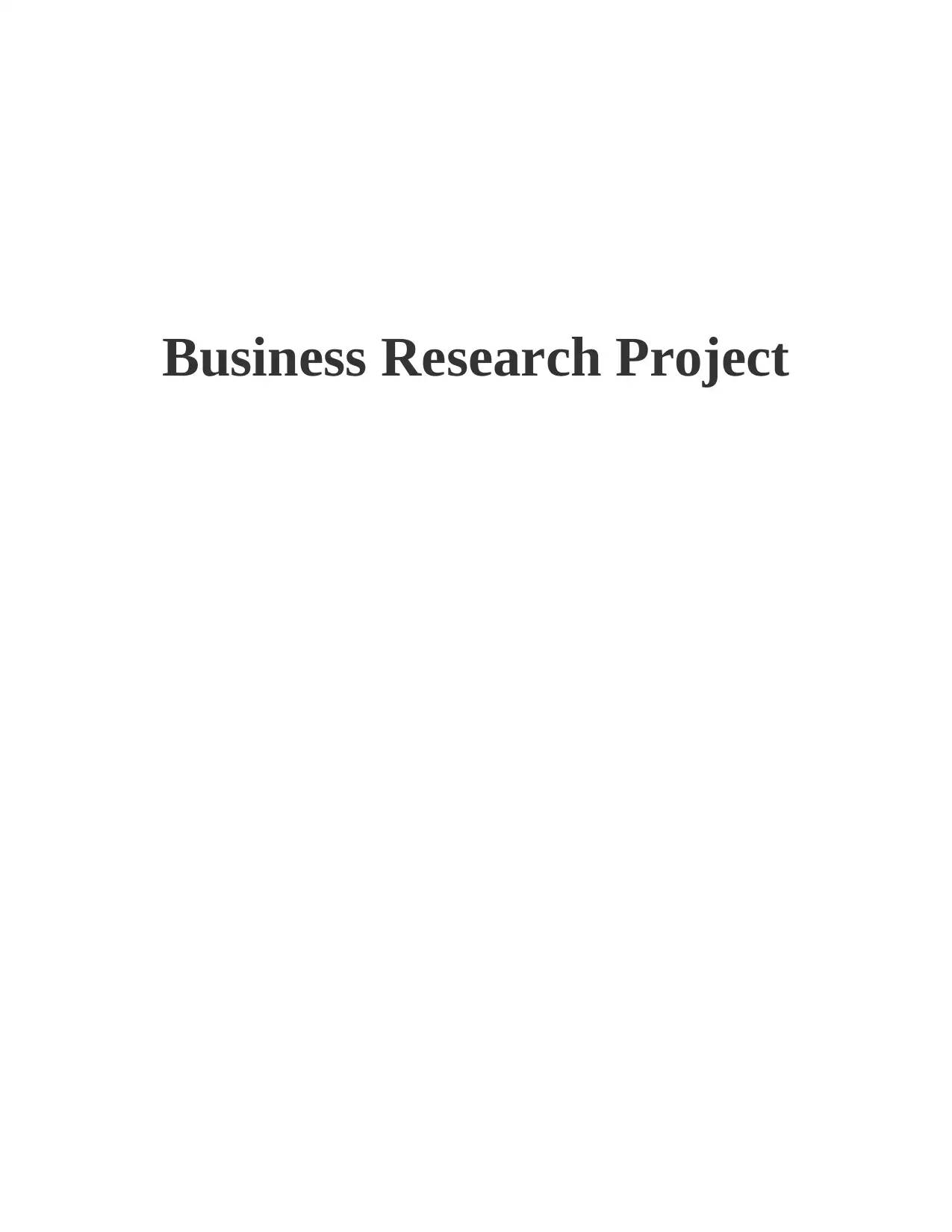
Business Research Project
Paraphrase This Document
Need a fresh take? Get an instant paraphrase of this document with our AI Paraphraser
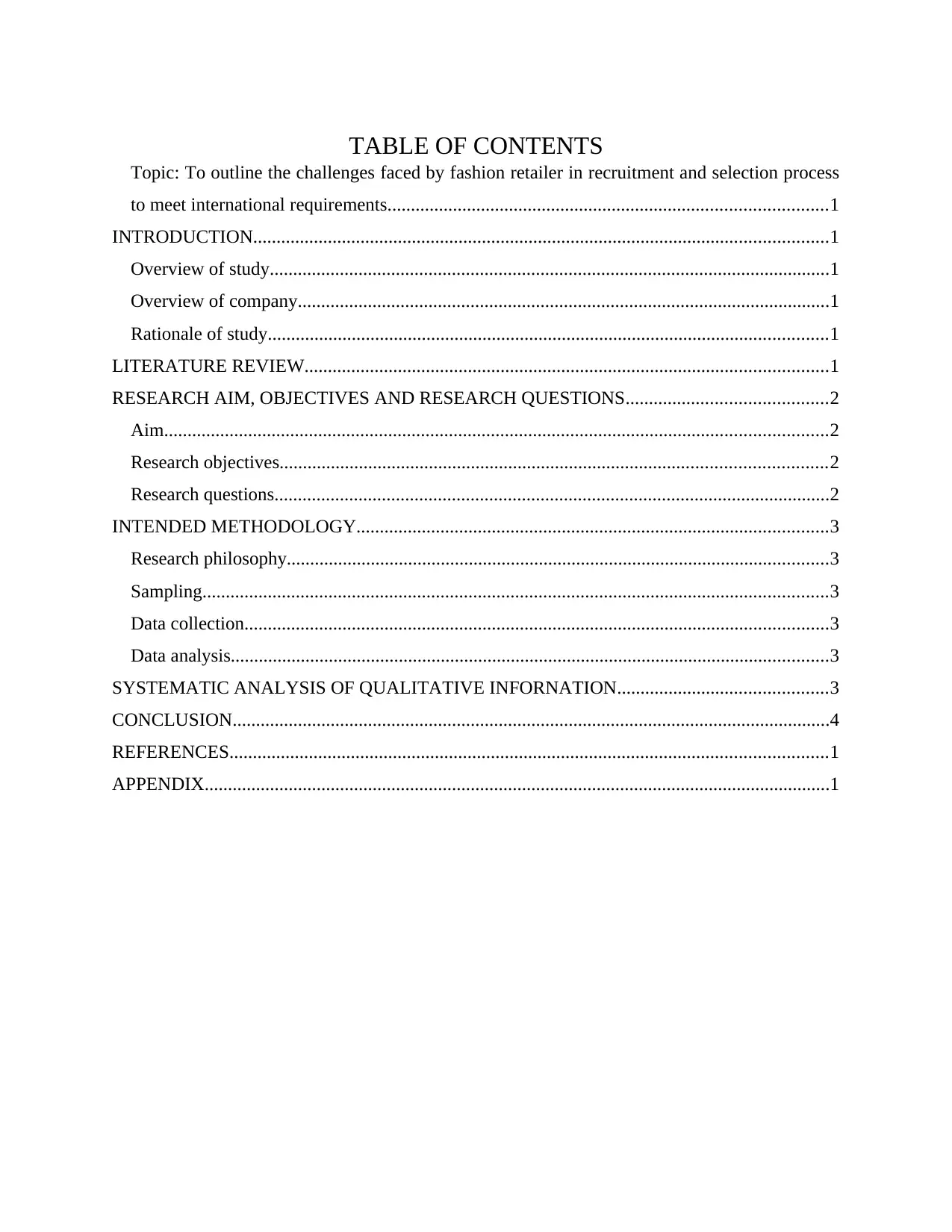
TABLE OF CONTENTS
Topic: To outline the challenges faced by fashion retailer in recruitment and selection process
to meet international requirements..............................................................................................1
INTRODUCTION...........................................................................................................................1
Overview of study........................................................................................................................1
Overview of company..................................................................................................................1
Rationale of study........................................................................................................................1
LITERATURE REVIEW................................................................................................................1
RESEARCH AIM, OBJECTIVES AND RESEARCH QUESTIONS...........................................2
Aim..............................................................................................................................................2
Research objectives.....................................................................................................................2
Research questions.......................................................................................................................2
INTENDED METHODOLOGY.....................................................................................................3
Research philosophy....................................................................................................................3
Sampling......................................................................................................................................3
Data collection.............................................................................................................................3
Data analysis................................................................................................................................3
SYSTEMATIC ANALYSIS OF QUALITATIVE INFORNATION.............................................3
CONCLUSION................................................................................................................................4
REFERENCES................................................................................................................................1
APPENDIX......................................................................................................................................1
Topic: To outline the challenges faced by fashion retailer in recruitment and selection process
to meet international requirements..............................................................................................1
INTRODUCTION...........................................................................................................................1
Overview of study........................................................................................................................1
Overview of company..................................................................................................................1
Rationale of study........................................................................................................................1
LITERATURE REVIEW................................................................................................................1
RESEARCH AIM, OBJECTIVES AND RESEARCH QUESTIONS...........................................2
Aim..............................................................................................................................................2
Research objectives.....................................................................................................................2
Research questions.......................................................................................................................2
INTENDED METHODOLOGY.....................................................................................................3
Research philosophy....................................................................................................................3
Sampling......................................................................................................................................3
Data collection.............................................................................................................................3
Data analysis................................................................................................................................3
SYSTEMATIC ANALYSIS OF QUALITATIVE INFORNATION.............................................3
CONCLUSION................................................................................................................................4
REFERENCES................................................................................................................................1
APPENDIX......................................................................................................................................1
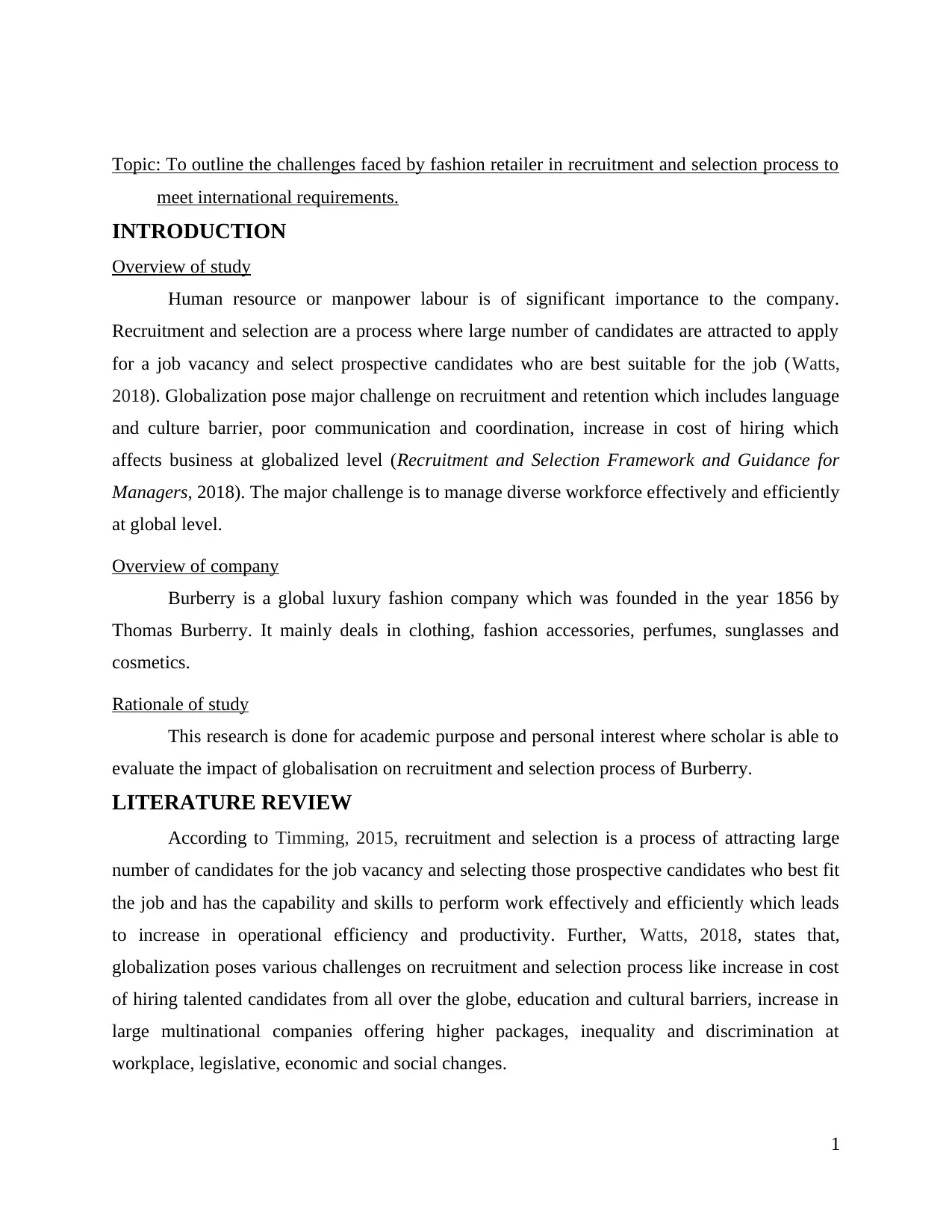
Topic: To outline the challenges faced by fashion retailer in recruitment and selection process to
meet international requirements.
INTRODUCTION
Overview of study
Human resource or manpower labour is of significant importance to the company.
Recruitment and selection are a process where large number of candidates are attracted to apply
for a job vacancy and select prospective candidates who are best suitable for the job (Watts,
2018). Globalization pose major challenge on recruitment and retention which includes language
and culture barrier, poor communication and coordination, increase in cost of hiring which
affects business at globalized level (Recruitment and Selection Framework and Guidance for
Managers, 2018). The major challenge is to manage diverse workforce effectively and efficiently
at global level.
Overview of company
Burberry is a global luxury fashion company which was founded in the year 1856 by
Thomas Burberry. It mainly deals in clothing, fashion accessories, perfumes, sunglasses and
cosmetics.
Rationale of study
This research is done for academic purpose and personal interest where scholar is able to
evaluate the impact of globalisation on recruitment and selection process of Burberry.
LITERATURE REVIEW
According to Timming, 2015, recruitment and selection is a process of attracting large
number of candidates for the job vacancy and selecting those prospective candidates who best fit
the job and has the capability and skills to perform work effectively and efficiently which leads
to increase in operational efficiency and productivity. Further, Watts, 2018, states that,
globalization poses various challenges on recruitment and selection process like increase in cost
of hiring talented candidates from all over the globe, education and cultural barriers, increase in
large multinational companies offering higher packages, inequality and discrimination at
workplace, legislative, economic and social changes.
1
meet international requirements.
INTRODUCTION
Overview of study
Human resource or manpower labour is of significant importance to the company.
Recruitment and selection are a process where large number of candidates are attracted to apply
for a job vacancy and select prospective candidates who are best suitable for the job (Watts,
2018). Globalization pose major challenge on recruitment and retention which includes language
and culture barrier, poor communication and coordination, increase in cost of hiring which
affects business at globalized level (Recruitment and Selection Framework and Guidance for
Managers, 2018). The major challenge is to manage diverse workforce effectively and efficiently
at global level.
Overview of company
Burberry is a global luxury fashion company which was founded in the year 1856 by
Thomas Burberry. It mainly deals in clothing, fashion accessories, perfumes, sunglasses and
cosmetics.
Rationale of study
This research is done for academic purpose and personal interest where scholar is able to
evaluate the impact of globalisation on recruitment and selection process of Burberry.
LITERATURE REVIEW
According to Timming, 2015, recruitment and selection is a process of attracting large
number of candidates for the job vacancy and selecting those prospective candidates who best fit
the job and has the capability and skills to perform work effectively and efficiently which leads
to increase in operational efficiency and productivity. Further, Watts, 2018, states that,
globalization poses various challenges on recruitment and selection process like increase in cost
of hiring talented candidates from all over the globe, education and cultural barriers, increase in
large multinational companies offering higher packages, inequality and discrimination at
workplace, legislative, economic and social changes.
1
⊘ This is a preview!⊘
Do you want full access?
Subscribe today to unlock all pages.

Trusted by 1+ million students worldwide
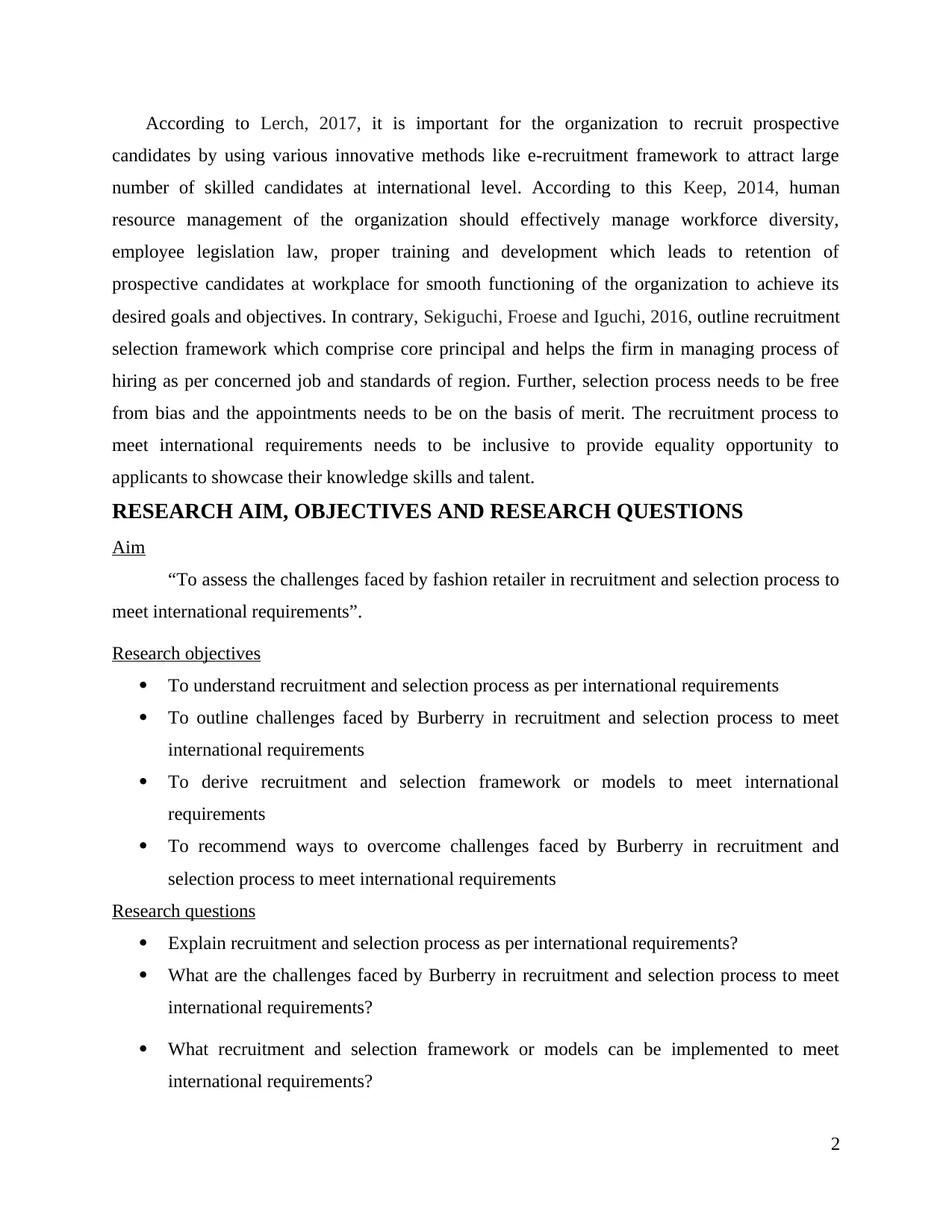
According to Lerch, 2017, it is important for the organization to recruit prospective
candidates by using various innovative methods like e-recruitment framework to attract large
number of skilled candidates at international level. According to this Keep, 2014, human
resource management of the organization should effectively manage workforce diversity,
employee legislation law, proper training and development which leads to retention of
prospective candidates at workplace for smooth functioning of the organization to achieve its
desired goals and objectives. In contrary, Sekiguchi, Froese and Iguchi, 2016, outline recruitment
selection framework which comprise core principal and helps the firm in managing process of
hiring as per concerned job and standards of region. Further, selection process needs to be free
from bias and the appointments needs to be on the basis of merit. The recruitment process to
meet international requirements needs to be inclusive to provide equality opportunity to
applicants to showcase their knowledge skills and talent.
RESEARCH AIM, OBJECTIVES AND RESEARCH QUESTIONS
Aim
“To assess the challenges faced by fashion retailer in recruitment and selection process to
meet international requirements”.
Research objectives
To understand recruitment and selection process as per international requirements
To outline challenges faced by Burberry in recruitment and selection process to meet
international requirements
To derive recruitment and selection framework or models to meet international
requirements
To recommend ways to overcome challenges faced by Burberry in recruitment and
selection process to meet international requirements
Research questions
Explain recruitment and selection process as per international requirements?
What are the challenges faced by Burberry in recruitment and selection process to meet
international requirements?
What recruitment and selection framework or models can be implemented to meet
international requirements?
2
candidates by using various innovative methods like e-recruitment framework to attract large
number of skilled candidates at international level. According to this Keep, 2014, human
resource management of the organization should effectively manage workforce diversity,
employee legislation law, proper training and development which leads to retention of
prospective candidates at workplace for smooth functioning of the organization to achieve its
desired goals and objectives. In contrary, Sekiguchi, Froese and Iguchi, 2016, outline recruitment
selection framework which comprise core principal and helps the firm in managing process of
hiring as per concerned job and standards of region. Further, selection process needs to be free
from bias and the appointments needs to be on the basis of merit. The recruitment process to
meet international requirements needs to be inclusive to provide equality opportunity to
applicants to showcase their knowledge skills and talent.
RESEARCH AIM, OBJECTIVES AND RESEARCH QUESTIONS
Aim
“To assess the challenges faced by fashion retailer in recruitment and selection process to
meet international requirements”.
Research objectives
To understand recruitment and selection process as per international requirements
To outline challenges faced by Burberry in recruitment and selection process to meet
international requirements
To derive recruitment and selection framework or models to meet international
requirements
To recommend ways to overcome challenges faced by Burberry in recruitment and
selection process to meet international requirements
Research questions
Explain recruitment and selection process as per international requirements?
What are the challenges faced by Burberry in recruitment and selection process to meet
international requirements?
What recruitment and selection framework or models can be implemented to meet
international requirements?
2
Paraphrase This Document
Need a fresh take? Get an instant paraphrase of this document with our AI Paraphraser
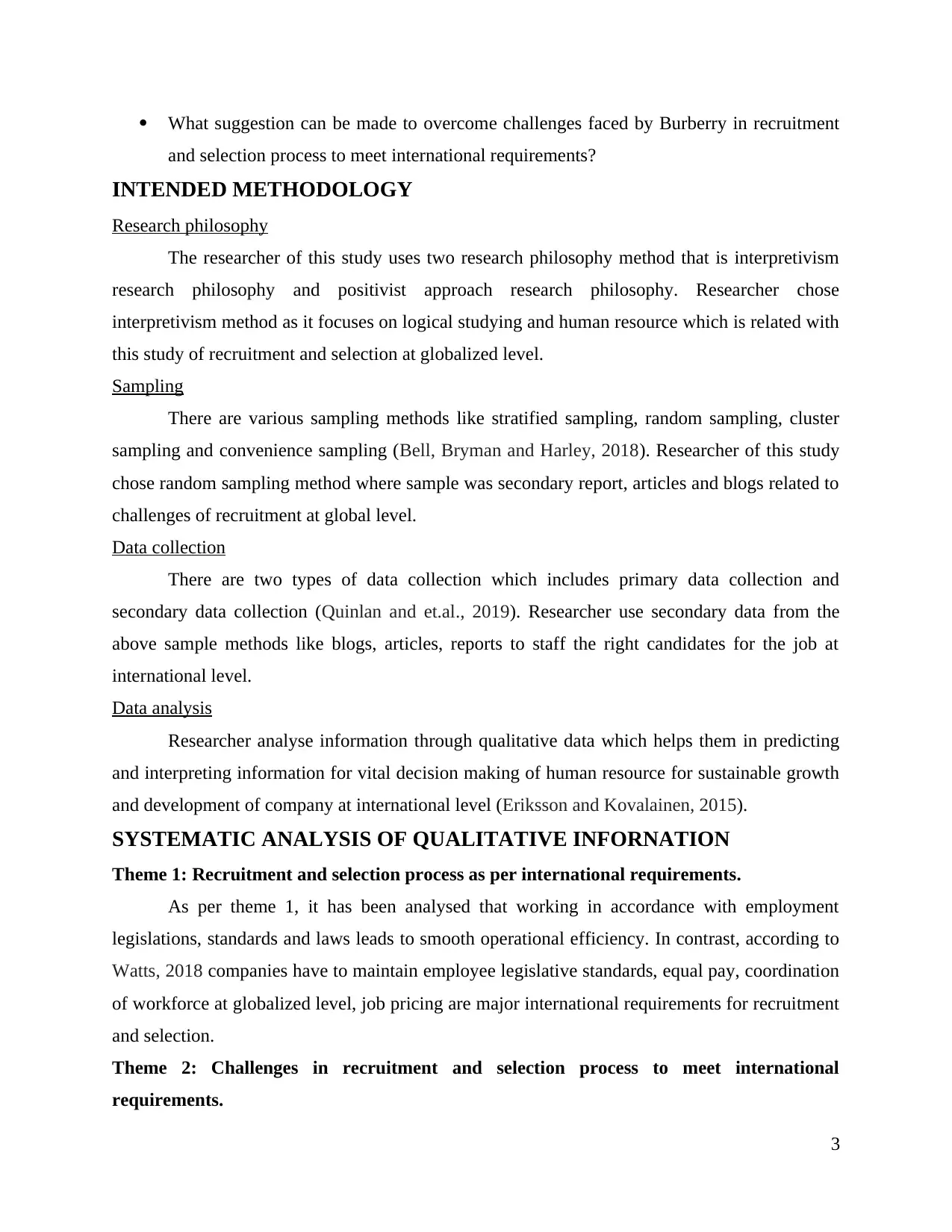
What suggestion can be made to overcome challenges faced by Burberry in recruitment
and selection process to meet international requirements?
INTENDED METHODOLOGY
Research philosophy
The researcher of this study uses two research philosophy method that is interpretivism
research philosophy and positivist approach research philosophy. Researcher chose
interpretivism method as it focuses on logical studying and human resource which is related with
this study of recruitment and selection at globalized level.
Sampling
There are various sampling methods like stratified sampling, random sampling, cluster
sampling and convenience sampling (Bell, Bryman and Harley, 2018). Researcher of this study
chose random sampling method where sample was secondary report, articles and blogs related to
challenges of recruitment at global level.
Data collection
There are two types of data collection which includes primary data collection and
secondary data collection (Quinlan and et.al., 2019). Researcher use secondary data from the
above sample methods like blogs, articles, reports to staff the right candidates for the job at
international level.
Data analysis
Researcher analyse information through qualitative data which helps them in predicting
and interpreting information for vital decision making of human resource for sustainable growth
and development of company at international level (Eriksson and Kovalainen, 2015).
SYSTEMATIC ANALYSIS OF QUALITATIVE INFORNATION
Theme 1: Recruitment and selection process as per international requirements.
As per theme 1, it has been analysed that working in accordance with employment
legislations, standards and laws leads to smooth operational efficiency. In contrast, according to
Watts, 2018 companies have to maintain employee legislative standards, equal pay, coordination
of workforce at globalized level, job pricing are major international requirements for recruitment
and selection.
Theme 2: Challenges in recruitment and selection process to meet international
requirements.
3
and selection process to meet international requirements?
INTENDED METHODOLOGY
Research philosophy
The researcher of this study uses two research philosophy method that is interpretivism
research philosophy and positivist approach research philosophy. Researcher chose
interpretivism method as it focuses on logical studying and human resource which is related with
this study of recruitment and selection at globalized level.
Sampling
There are various sampling methods like stratified sampling, random sampling, cluster
sampling and convenience sampling (Bell, Bryman and Harley, 2018). Researcher of this study
chose random sampling method where sample was secondary report, articles and blogs related to
challenges of recruitment at global level.
Data collection
There are two types of data collection which includes primary data collection and
secondary data collection (Quinlan and et.al., 2019). Researcher use secondary data from the
above sample methods like blogs, articles, reports to staff the right candidates for the job at
international level.
Data analysis
Researcher analyse information through qualitative data which helps them in predicting
and interpreting information for vital decision making of human resource for sustainable growth
and development of company at international level (Eriksson and Kovalainen, 2015).
SYSTEMATIC ANALYSIS OF QUALITATIVE INFORNATION
Theme 1: Recruitment and selection process as per international requirements.
As per theme 1, it has been analysed that working in accordance with employment
legislations, standards and laws leads to smooth operational efficiency. In contrast, according to
Watts, 2018 companies have to maintain employee legislative standards, equal pay, coordination
of workforce at globalized level, job pricing are major international requirements for recruitment
and selection.
Theme 2: Challenges in recruitment and selection process to meet international
requirements.
3
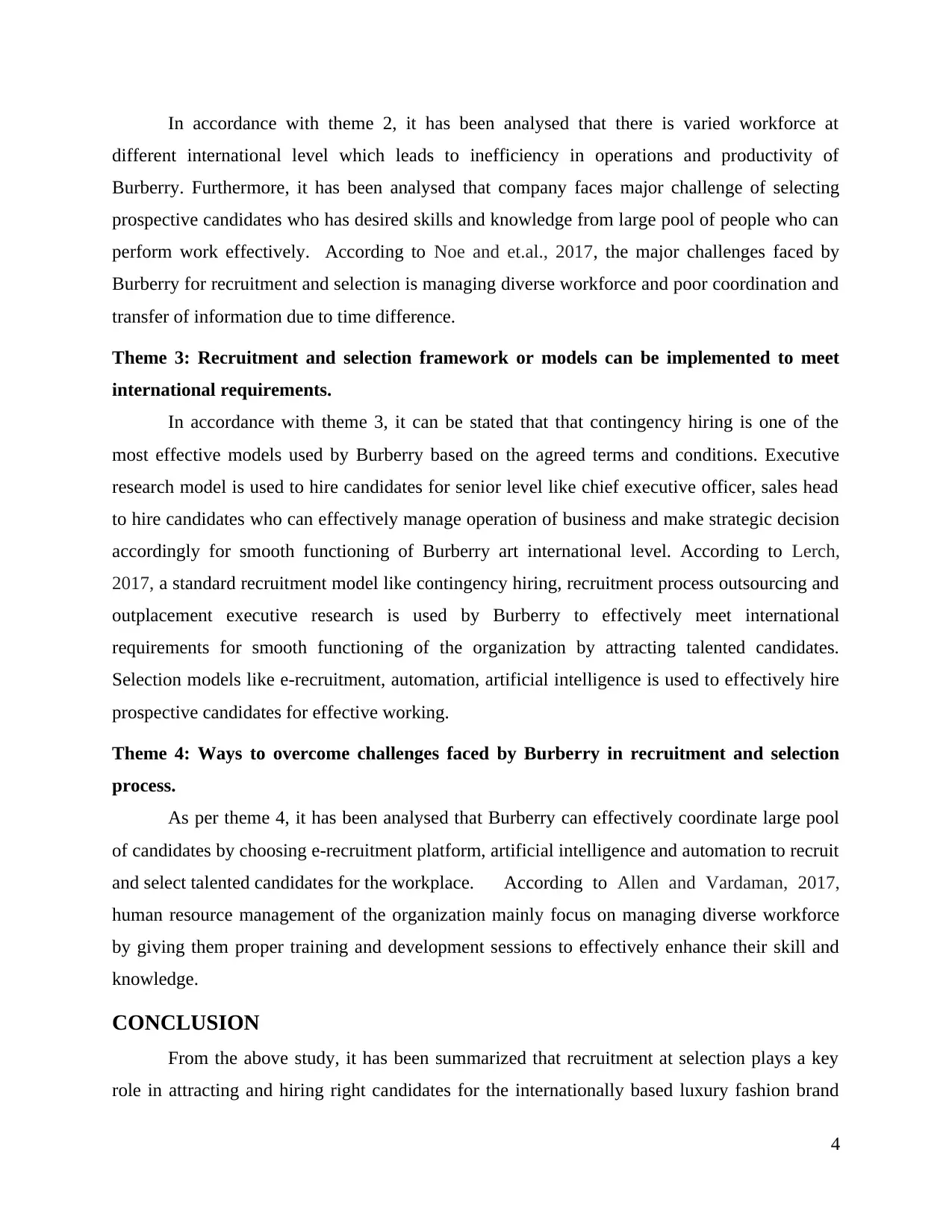
In accordance with theme 2, it has been analysed that there is varied workforce at
different international level which leads to inefficiency in operations and productivity of
Burberry. Furthermore, it has been analysed that company faces major challenge of selecting
prospective candidates who has desired skills and knowledge from large pool of people who can
perform work effectively. According to Noe and et.al., 2017, the major challenges faced by
Burberry for recruitment and selection is managing diverse workforce and poor coordination and
transfer of information due to time difference.
Theme 3: Recruitment and selection framework or models can be implemented to meet
international requirements.
In accordance with theme 3, it can be stated that that contingency hiring is one of the
most effective models used by Burberry based on the agreed terms and conditions. Executive
research model is used to hire candidates for senior level like chief executive officer, sales head
to hire candidates who can effectively manage operation of business and make strategic decision
accordingly for smooth functioning of Burberry art international level. According to Lerch,
2017, a standard recruitment model like contingency hiring, recruitment process outsourcing and
outplacement executive research is used by Burberry to effectively meet international
requirements for smooth functioning of the organization by attracting talented candidates.
Selection models like e-recruitment, automation, artificial intelligence is used to effectively hire
prospective candidates for effective working.
Theme 4: Ways to overcome challenges faced by Burberry in recruitment and selection
process.
As per theme 4, it has been analysed that Burberry can effectively coordinate large pool
of candidates by choosing e-recruitment platform, artificial intelligence and automation to recruit
and select talented candidates for the workplace. According to Allen and Vardaman, 2017,
human resource management of the organization mainly focus on managing diverse workforce
by giving them proper training and development sessions to effectively enhance their skill and
knowledge.
CONCLUSION
From the above study, it has been summarized that recruitment at selection plays a key
role in attracting and hiring right candidates for the internationally based luxury fashion brand
4
different international level which leads to inefficiency in operations and productivity of
Burberry. Furthermore, it has been analysed that company faces major challenge of selecting
prospective candidates who has desired skills and knowledge from large pool of people who can
perform work effectively. According to Noe and et.al., 2017, the major challenges faced by
Burberry for recruitment and selection is managing diverse workforce and poor coordination and
transfer of information due to time difference.
Theme 3: Recruitment and selection framework or models can be implemented to meet
international requirements.
In accordance with theme 3, it can be stated that that contingency hiring is one of the
most effective models used by Burberry based on the agreed terms and conditions. Executive
research model is used to hire candidates for senior level like chief executive officer, sales head
to hire candidates who can effectively manage operation of business and make strategic decision
accordingly for smooth functioning of Burberry art international level. According to Lerch,
2017, a standard recruitment model like contingency hiring, recruitment process outsourcing and
outplacement executive research is used by Burberry to effectively meet international
requirements for smooth functioning of the organization by attracting talented candidates.
Selection models like e-recruitment, automation, artificial intelligence is used to effectively hire
prospective candidates for effective working.
Theme 4: Ways to overcome challenges faced by Burberry in recruitment and selection
process.
As per theme 4, it has been analysed that Burberry can effectively coordinate large pool
of candidates by choosing e-recruitment platform, artificial intelligence and automation to recruit
and select talented candidates for the workplace. According to Allen and Vardaman, 2017,
human resource management of the organization mainly focus on managing diverse workforce
by giving them proper training and development sessions to effectively enhance their skill and
knowledge.
CONCLUSION
From the above study, it has been summarized that recruitment at selection plays a key
role in attracting and hiring right candidates for the internationally based luxury fashion brand
4
⊘ This is a preview!⊘
Do you want full access?
Subscribe today to unlock all pages.

Trusted by 1+ million students worldwide
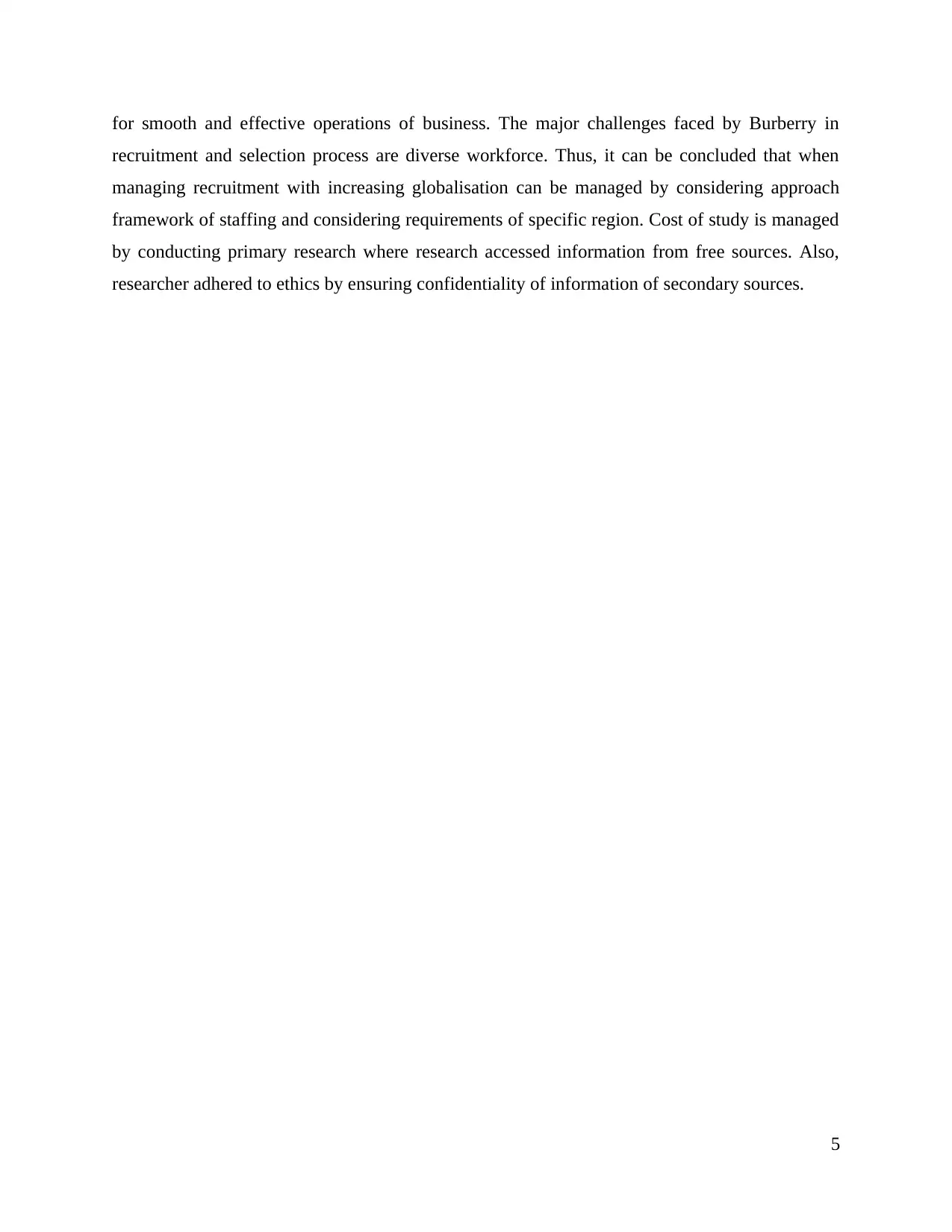
for smooth and effective operations of business. The major challenges faced by Burberry in
recruitment and selection process are diverse workforce. Thus, it can be concluded that when
managing recruitment with increasing globalisation can be managed by considering approach
framework of staffing and considering requirements of specific region. Cost of study is managed
by conducting primary research where research accessed information from free sources. Also,
researcher adhered to ethics by ensuring confidentiality of information of secondary sources.
5
recruitment and selection process are diverse workforce. Thus, it can be concluded that when
managing recruitment with increasing globalisation can be managed by considering approach
framework of staffing and considering requirements of specific region. Cost of study is managed
by conducting primary research where research accessed information from free sources. Also,
researcher adhered to ethics by ensuring confidentiality of information of secondary sources.
5
Paraphrase This Document
Need a fresh take? Get an instant paraphrase of this document with our AI Paraphraser
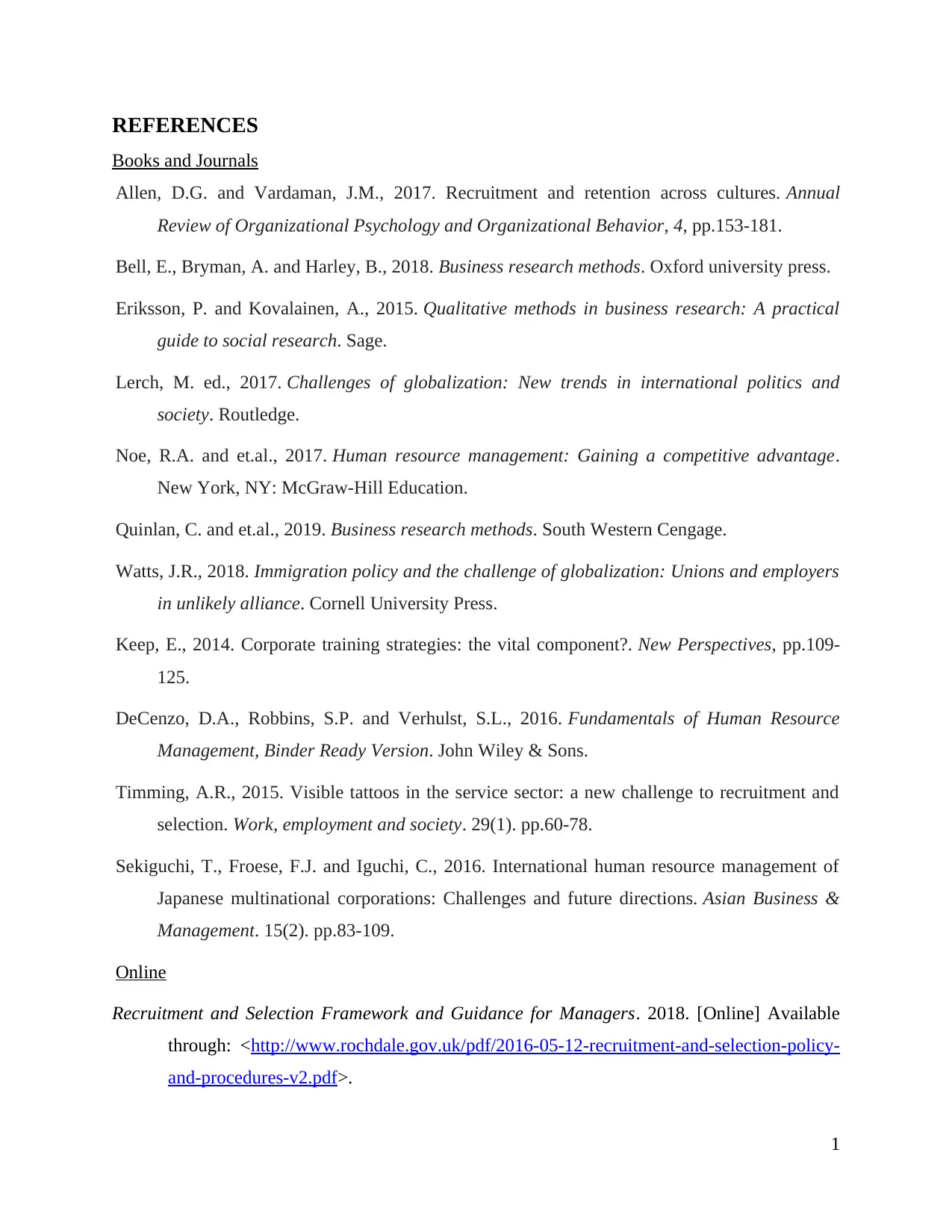
REFERENCES
Books and Journals
Allen, D.G. and Vardaman, J.M., 2017. Recruitment and retention across cultures. Annual
Review of Organizational Psychology and Organizational Behavior, 4, pp.153-181.
Bell, E., Bryman, A. and Harley, B., 2018. Business research methods. Oxford university press.
Eriksson, P. and Kovalainen, A., 2015. Qualitative methods in business research: A practical
guide to social research. Sage.
Lerch, M. ed., 2017. Challenges of globalization: New trends in international politics and
society. Routledge.
Noe, R.A. and et.al., 2017. Human resource management: Gaining a competitive advantage.
New York, NY: McGraw-Hill Education.
Quinlan, C. and et.al., 2019. Business research methods. South Western Cengage.
Watts, J.R., 2018. Immigration policy and the challenge of globalization: Unions and employers
in unlikely alliance. Cornell University Press.
Keep, E., 2014. Corporate training strategies: the vital component?. New Perspectives, pp.109-
125.
DeCenzo, D.A., Robbins, S.P. and Verhulst, S.L., 2016. Fundamentals of Human Resource
Management, Binder Ready Version. John Wiley & Sons.
Timming, A.R., 2015. Visible tattoos in the service sector: a new challenge to recruitment and
selection. Work, employment and society. 29(1). pp.60-78.
Sekiguchi, T., Froese, F.J. and Iguchi, C., 2016. International human resource management of
Japanese multinational corporations: Challenges and future directions. Asian Business &
Management. 15(2). pp.83-109.
Online
Recruitment and Selection Framework and Guidance for Managers. 2018. [Online] Available
through: <http://www.rochdale.gov.uk/pdf/2016-05-12-recruitment-and-selection-policy-
and-procedures-v2.pdf>.
1
Books and Journals
Allen, D.G. and Vardaman, J.M., 2017. Recruitment and retention across cultures. Annual
Review of Organizational Psychology and Organizational Behavior, 4, pp.153-181.
Bell, E., Bryman, A. and Harley, B., 2018. Business research methods. Oxford university press.
Eriksson, P. and Kovalainen, A., 2015. Qualitative methods in business research: A practical
guide to social research. Sage.
Lerch, M. ed., 2017. Challenges of globalization: New trends in international politics and
society. Routledge.
Noe, R.A. and et.al., 2017. Human resource management: Gaining a competitive advantage.
New York, NY: McGraw-Hill Education.
Quinlan, C. and et.al., 2019. Business research methods. South Western Cengage.
Watts, J.R., 2018. Immigration policy and the challenge of globalization: Unions and employers
in unlikely alliance. Cornell University Press.
Keep, E., 2014. Corporate training strategies: the vital component?. New Perspectives, pp.109-
125.
DeCenzo, D.A., Robbins, S.P. and Verhulst, S.L., 2016. Fundamentals of Human Resource
Management, Binder Ready Version. John Wiley & Sons.
Timming, A.R., 2015. Visible tattoos in the service sector: a new challenge to recruitment and
selection. Work, employment and society. 29(1). pp.60-78.
Sekiguchi, T., Froese, F.J. and Iguchi, C., 2016. International human resource management of
Japanese multinational corporations: Challenges and future directions. Asian Business &
Management. 15(2). pp.83-109.
Online
Recruitment and Selection Framework and Guidance for Managers. 2018. [Online] Available
through: <http://www.rochdale.gov.uk/pdf/2016-05-12-recruitment-and-selection-policy-
and-procedures-v2.pdf>.
1
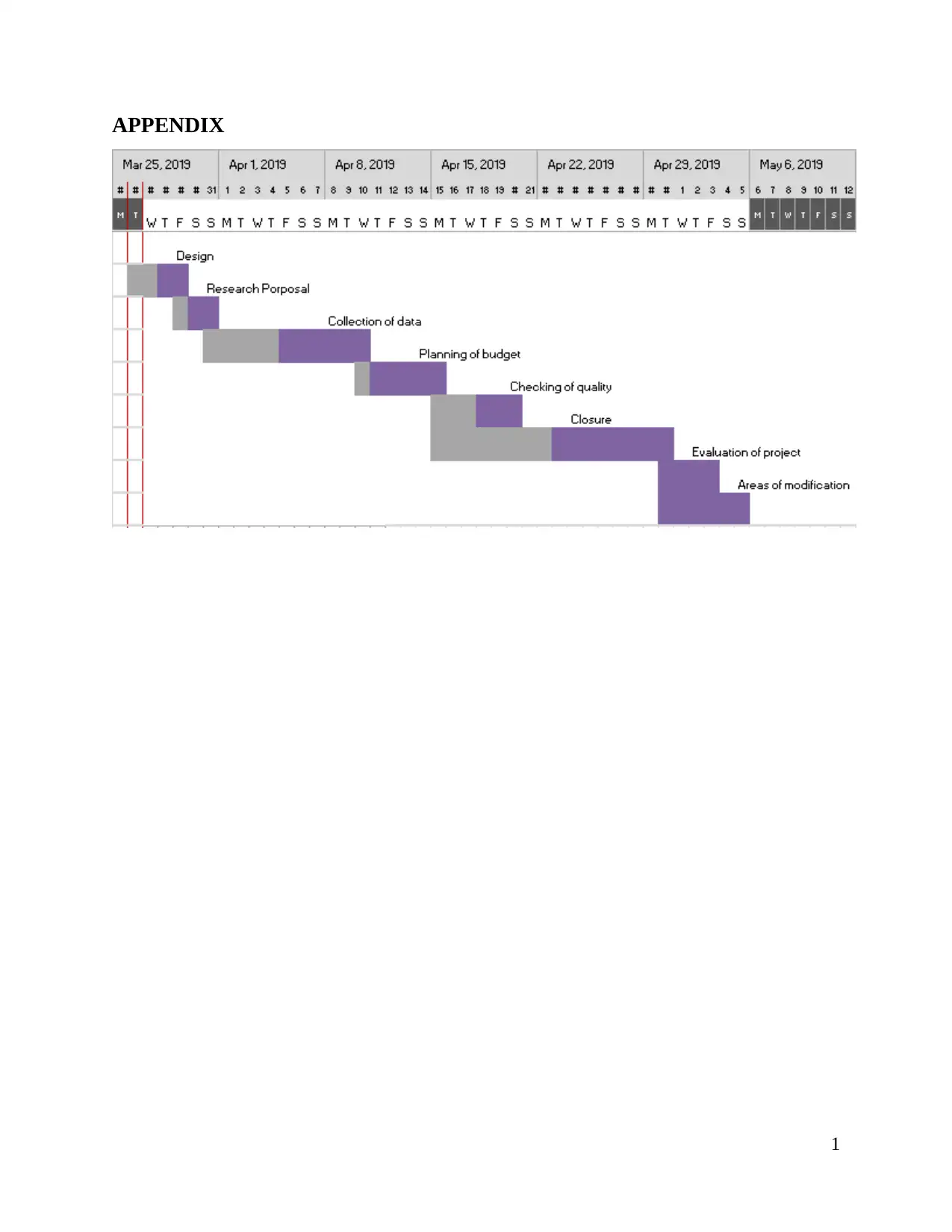
APPENDIX
1
1
⊘ This is a preview!⊘
Do you want full access?
Subscribe today to unlock all pages.

Trusted by 1+ million students worldwide
1 out of 9
Related Documents
Your All-in-One AI-Powered Toolkit for Academic Success.
+13062052269
info@desklib.com
Available 24*7 on WhatsApp / Email
![[object Object]](/_next/static/media/star-bottom.7253800d.svg)
Unlock your academic potential
Copyright © 2020–2025 A2Z Services. All Rights Reserved. Developed and managed by ZUCOL.




